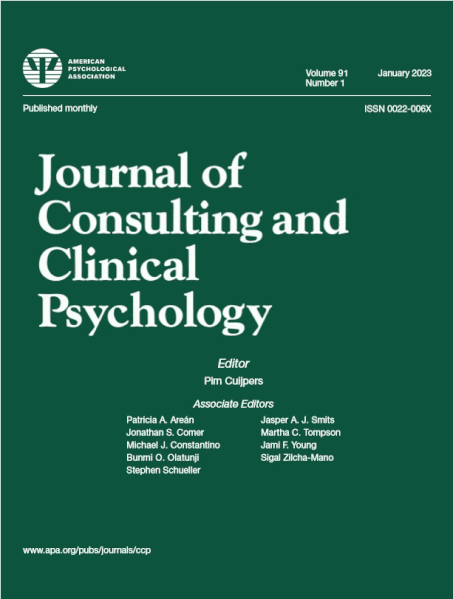Disentangling between- and within-patients effects of emotion regulation on outcome in naturalistic psychotherapy.
IF 5
1区 心理学
Q1 PSYCHOLOGY, CLINICAL
引用次数: 0
Abstract
OBJECTIVE The aim of this study was to disaggregate the between-patient and within-patient effects of emotion regulation (ER) on treatment outcome and explore relevant trait-like moderators of the within-patient effects. METHOD Three hundred thirty-nine patients with heterogenous clinical conditions were admitted to psychotherapy at a clinical center. During the intake evaluation, patients completed the Inventory of Interpersonal Problems, the Outcome Questionnaire 30, and the State Difficulties of Emotion Regulation Scale. Subsequently, patients responded to the Outcome Questionnaire 30 and State Difficulties of Emotion Regulation Scale every session for the initial five sessions, followed by assessments every two sessions until the 15th session and then every four sessions until the end of treatment. RESULTS Multilevel models revealed significant between- and within-patient effects of ER on clinical distress. That is, patients with lower average levels of ER difficulties showed greater benefit from treatment, and lower ER difficulties over the course of treatment were associated with lower clinical distress. Furthermore, interactive models demonstrated that lower average levels of ER throughout treatment and fewer interpersonal problems at the beginning of treatment were associated with better treatment outcome. CONCLUSION These findings provide evidence supporting the role of ER as a mechanism of change. The interaction between trait-like components and state-like fluctuations of ER suggests a capitalization model for the role of ER in psychotherapy. (PsycInfo Database Record (c) 2024 APA, all rights reserved).在自然心理疗法中,厘清情绪调节对患者之间和患者内部疗效的影响。
目的:本研究旨在对情绪调节(ER)对治疗结果的患者间效应和患者内效应进行分类,并探索患者内效应的相关特质调节因子。方法:某临床中心接收了339名患有不同临床症状的患者进行心理治疗。在入院评估期间,患者填写了人际关系问题量表、结果问卷 30 和情绪调节状态困难量表。随后,在最初的五个疗程中,患者在每个疗程都回答了结果问卷 30 和情绪调节状态困难量表,之后每两个疗程评估一次,直到第 15 个疗程,然后每四个疗程评估一次,直到治疗结束。也就是说,平均急诊室困难程度较低的患者从治疗中获益更大,而在治疗过程中急诊室困难程度较低的患者临床痛苦程度也较低。此外,互动模型显示,在整个治疗过程中,ER平均水平较低以及治疗初期人际关系问题较少的患者与较好的治疗效果相关。ER的特质类成分和状态类波动之间的相互作用为ER在心理治疗中的作用提供了一个资本化模型。(PsycInfo Database Record (c) 2024 APA,保留所有权利)。
本文章由计算机程序翻译,如有差异,请以英文原文为准。
求助全文
约1分钟内获得全文
求助全文
来源期刊

Journal of consulting and clinical psychology
PSYCHOLOGY, CLINICAL-
CiteScore
9.00
自引率
3.40%
发文量
94
期刊介绍:
The Journal of Consulting and Clinical Psychology® (JCCP) publishes original contributions on the following topics: the development, validity, and use of techniques of diagnosis and treatment of disordered behaviorstudies of a variety of populations that have clinical interest, including but not limited to medical patients, ethnic minorities, persons with serious mental illness, and community samplesstudies that have a cross-cultural or demographic focus and are of interest for treating behavior disordersstudies of personality and of its assessment and development where these have a clear bearing on problems of clinical dysfunction and treatmentstudies of gender, ethnicity, or sexual orientation that have a clear bearing on diagnosis, assessment, and treatmentstudies of psychosocial aspects of health behaviors. Studies that focus on populations that fall anywhere within the lifespan are considered. JCCP welcomes submissions on treatment and prevention in all areas of clinical and clinical–health psychology and especially on topics that appeal to a broad clinical–scientist and practitioner audience. JCCP encourages the submission of theory–based interventions, studies that investigate mechanisms of change, and studies of the effectiveness of treatments in real-world settings. JCCP recommends that authors of clinical trials pre-register their studies with an appropriate clinical trial registry (e.g., ClinicalTrials.gov, ClinicalTrialsRegister.eu) though both registered and unregistered trials will continue to be considered at this time.
 求助内容:
求助内容: 应助结果提醒方式:
应助结果提醒方式:


